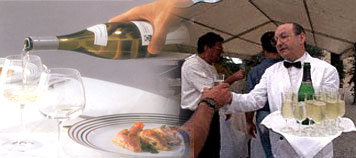

Serving wine covers what to do between choosing which bottles of wine to open and enjoying them in the glass. One can indeed should be very relaxed about this on most occasions. A corkscrew and a glass are all you need when the wine is simple, the occasion informal, the decision to open a bottle perhaps spontaneous. But even a simple bottle tastes better at the right temperature. Even a minor wine is best appreciated in the right glass. And if the wine is a little more serious, the occasion more formal, so much pleasure can be gained from following the right procedures when serving wine.
The techniques of serving follow on from those of storing wine. Allow wine time: a bottle that is rushed to table, straight from a shopping bag, can never be at its best. This matters little with everyday wines, but finer, older ones do suffer from being moved, and regain their balance and character only after a period of rest, preferably in a cool, dark place. With some fine wines those prone to develop a deposit in bottle stability is vital. It is best to plan ahead and stand such wines up two days before drinking to allow the deposit to settle on the bottom, rather than the side, of the bottle. Temperature is the next thing to consider when serving wine, as it takes a while to alter. Allow time for bottles to chill
or warm up before a meal. Then, check on the quantity, type and most neglected, but most important the cleanliness of the glasses you will require. And always include water glasses, and jugs or bottles of chilled water, on the table. Assemble decanters as necessary, checking that they too are clean and free of trapped, stale air and lingering odours.
Finally, consider the order of service: which wine comes first? Will there be two wines on the table at once, so guests can compare them? This is normal for groups of wine lovers, but can be an eye-opener for other guests too. If two wines are to be served, mark the glasses so that everyone knows which wine is which. Small elastic bands around the stem, or a dab of washable white paint on the glass foot, are two ways to distinguish between identical glasses. Or use glasses of distinctly different styles.
|
|
|


